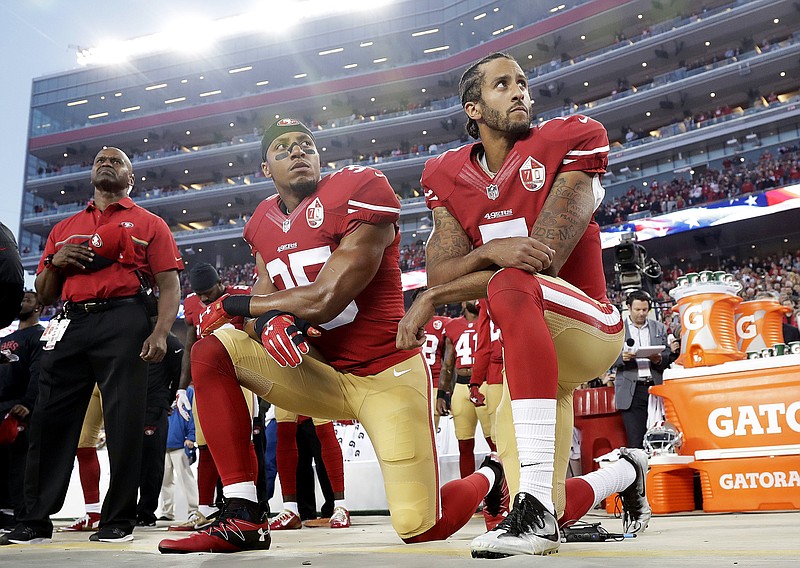As San Francisco 49ers quarterback Colin Kaepernick has painfully yet vividly reminded us the past few weeks, when it comes to race relations in this country, perspective is everything.
Not everything regarding whites and blacks in these somewhat United States of America can be explained in black and white. Gray abounds. Or at least two opposite but equally black-and-white views, one side's hope the other side's hell.
And so it is with "More Than Rivals" by New York Times best-selling author Ken Abraham, which documents a Tennessee high school basketball playoff game in 1970 between all-white Gallatin High School and all-black Union High School, which closed at the end of that school year.
The story centers on Gallatin High's Eddie Sherlin - the state's leading scorer that season - and Union's Bill Ligon, who went on to a fine career at Vanderbilt before playing a season with the NBA's Detroit Pistons.
Having first met on the playground in Gallatin's "black section," as Sherlin termed it, the two became friends, though as Ligon said Wednesday, "(After elementary school) we didn't see each other for three or four years despite living only seven or eight streets apart."
Explained Sherlin earlier this week of the first meeting between the two in 1963, a description that perfectly frames Southern racial attitudes of that era: "You didn't mingle with blacks in our town. There were water fountains for blacks and water fountains for whites. At the movie theater, blacks sat in the balcony. Normally, if I had to pass through the black section, I would run as fast as I could."
But one day - Sherlin calls it a "God moment" - he saw Ligon and some other black kids playing hoops. He asked if he could join them.
"They said I could play if I could shoot," Sherlin recalled. "I was pretty good, so I played that day and Bill and I became friends."
He never told his parents, though.
"As long as you were home for dinner, they didn't ask much about where you'd been," he said. "Kids played outside all day back then. So they were never worried about where I'd been."
Added Ligon: "Parents, adults in general, were at the heart of so much of the problem. When you were a black kid in the 1960s, everything you did was a social experiment. When I first met Eddie, I'd already been caddying at the country club for two years. You couldn't walk by the pool because you weren't supposed to look at the white girls. When it came to first meeting Eddie, we were just kids playing. We didn't care what color he was."
But by spring 1970, the town of Gallatin had become all about color. Dr. Martin Luther King Jr. had been murdered two years earlier in Memphis. The town had a curfew. The black community was losing its high school.
"Things weren't good," said Sherlin. "When we took the court for the district championship game in Springfield, the blacks were on one side and the whites on the other. There were teachers surrounding the court. The police were there, too. And when the game started, one of Union's players knocked out one of our players with an elbow. It was about to blow up."
Tied at halftime, Gallatin won on the strength of a stunning second half by Sherlin, who scored 17 points in the third quarter alone.
But it was what happened afterward that led to Abraham writing the book that Sherlin will autograph and sell copies of from 5 to 8 p.m. tonight at the Museum at Five Points in Cleveland, Tenn.
"I came out to the middle of the court as the MVP," he said. "Bill came out next. We were both crying - me because I was so happy, Bill because this was Union's last game. Nobody knew we were friends. I just grabbed him and hugged him and told him, 'Everything will be all right.' The tension left the building."
Gallatin administrators later told Sherlin the hug was bigger than the championship. The late journalist John Seigenthaler, editor of the Tennessean newspaper at that time, reportedly said of the hug, "That was the greatest thing that could have happened for desegregation in Middle Tennessee."
Ligon still calls Sherlin "a good friend" and hopes the book has "great success," but as one might expect of a 64-year-old black attorney who once made a 31 on his ACT, a 1480 on his SAT and was admitted to both Princeton and Vanderbilt before later earning a law degree from VU in 1979, he does not quietly suffer fools or avoid the elephant in the room.
"No caucasian knows anything about segregation," said Ligon, who once recruited former Riverside star Clarence Smith to Vandy during his time as a VU assistant. "This is a fairy tale.
"This (book) doesn't excite me at all. I never think about (that game). Eddie hugged me and I hugged him. But when I started helping with this book, I cried, I screamed, I yelled. It was difficult to relive this. We (black males) were all seen as boogie men back then. I'm sick of the fantasy about all this."
Neither man sees anything remotely resembling fantasy with the nation's current racial unrest, however.
"We haven't gone anywhere," said Ligon. "All this (black unrest) does is stir intense fear of the black man. We're never about 'we.' It's always us and them."
Said Sherlin, who declined a basketball scholarship to Tennessee to play pro baseball for a time with the Pittsburgh and Cincinnati organizations: "I'd begun to think we'd gotten past it. Now it looks like we're going back to where we were in the 1960s, and that wasn't any good at all. We need a change of heart, not a change of minds."
Maybe one day.
Contact Mark Wiedmer at mwiedmer@timesfreepress.com.

